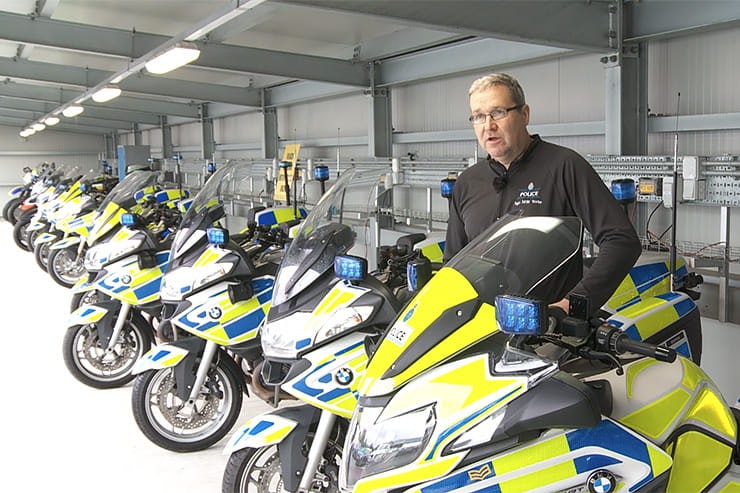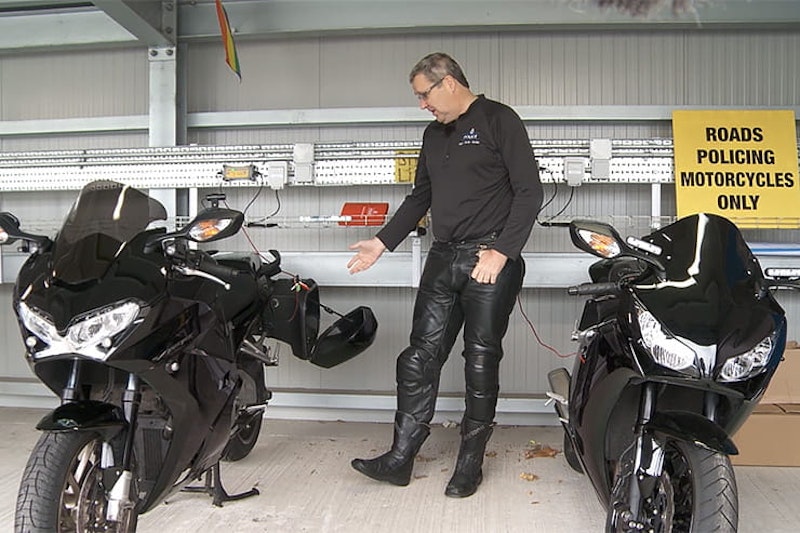How fast are police motorcycles? Ex-sergeant reveals all
By Dave Yorke
Freelance journalist
22.06.2023
Dave Yorke served as a VIPEX rider in Merseyside, and worked alongside the Special Escort Group in London
It’s got a cop motor, cop brakes and cop suspension… but has it? Just how fast can police bikes go, and do they have limits?
We all know performance bikes are fast; some say they’re too fast for the road, which is of course rubbish. Most bikes and cars on the roads today are more than capable of travelling faster than the speed limits in the UK, and even bicycles in the right hands – or legs as the case may be – can rip past the 20 mph limits in towns and cities, though the speed limits don’t apply to them (they could still be prosecuted for ‘wanton and furious cycling’).
So with that argument out of the way we can get back to the original question: just how fast can police motorbikes go?
The answer, in pure mechanical terms, is that they can go as fast as the equivalent road bike that you can buy from your local dealership.
The police aren’t into upgrading engine parts, mapping, adding turbos or upping the suspension or brakes: they rely on the rider to use their knowledge and experience to get the best out of a bike, although flashing blue lights and a siren provide an advantage over the average commute.
Even the unmarked police bikes tend to be standard when it comes to performance, though check out the video below to find out what’s in the panniers…
That doesn’t mean that police bikes get ridden flat out everywhere – if you’ve ridden as quickly and as safely as possible but still arrive a little late, it doesn’t matter as it’s better to arrive late and help, rather than not arrive at all.
When it comes to getting to the scene of an incident or carrying out some other policing situation, a huge plus that police riders carry over even the most advanced civilian motorcyclists are the exemptions in the Road Traffic Act, which enable a police rider to go onto the wrong side of a keep-left bollard, to contravene traffic signals and, of course, to exceed the speed limit.
It’s not a carte blanche exemption though – it has to be for a policing purpose, and in the great tradition of British law-makers ensuring that the law can be as clear as mud, the policing purpose of the exemption isn’t defined.
One could almost assume that doing anything could be a policing purpose if the rider is a police officer and is doing something for the benefit of policing… a policing purpose you might say. The law does, however, say that the exemption applies if the observance of that provision would be likely to hinder the use of the vehicle for the purpose for which it is being used on that occasion. So, let’s have a look at the exemptions…
Can police motorcycle riders use the wrong side of the road?
Contravening a keep-left bollard is a simple one: police riders can go onto the wrong side of a keep-left bollard. This is incredibly useful when overtaking stationary traffic in the rush hour to avoid coming to a bottle-neck caused by a bollard forcing you to try to merge back into the traffic until you advance beyond it and resume the overtaking.
Notice I said overtaking – filtering is going between lines of traffic moving in the same direction; anything else is overtaking.
Anyway, the cops don’t have to worry about that, and if it’s for a police purpose where observing the keep-left would hinder them, they can take a nice wide arc around the bollard, remembering that the traffic islands that bollards are situated on often have drop-kerbs allowing pedestrians to cross, so the wide arc helps to see any pedestrians who might assume that traffic approaching them won’t be on the wrong side of the road. And bearing in mind that pedestrians can cross from both sides of the road.
If they were just on a general patrol, I’d expect a police rider to be sitting in traffic, just like the rest of us, but police riders don’t have to display blue lights and sound sirens to use an exemption. And not all police purposes will be visible to other road users.
The same applies to crossing a solid white line, though officers have weeks of intensive training to enable them to use the exemptions available to them as safely as possible in order to make safe progress.
Can police motorcycle riders jump a red light?
Although cops have the right via exemption to contravene a red traffic light, they don’t have a right to just scream through them without making sure it’s clear first, and so there’s a routine to go through to keep it all safe.
Unless they can see that it’s all clear and there is no possibility of coming into any form of contact with another road user, then police riders should treat the red light as a give-way line. Remember the offence of contravening a red light is completed as soon as a rider crosses the line, and after a police rider has crossed that line they are, so to speak, into unchartered waters.
Police riders and drivers should really treat each time they could meet the public as a give-way line, so imagine crossing a dual carriageway: that could be up to five or more notional give-way lines in one junction. It’s the reason you see police – and other emergency vehicles – crawling through junctions.
We talked about red light cameras in this article, and Section 35 of the Road Traffic Act states that a police officer or traffic officer directing traffic can direct you, a normal road user, to stop or proceed in, or keep to a particular line of traffic. So what if that ‘proceed in a particular line of traffic’ involves going through a red light for whatever reason? I can think of a couple of reasons that might happen.
The power to direct traffic in those circumstances only applies to police officers and traffic officers who are directing traffic at the time – it doesn’t apply to other emergency services. Don’t get confused by the term traffic officer either, it’s not referring to a police officer in a roads policing department, who are commonly called – among other things – traffic officers. It is instead referring to Highways Agency Traffic Officers and the law was amended to give them the power as well. Not the power to contravene red lights, but the power to direct traffic. This means that, as long as you were directed to do so only by a police or traffic officer, you as a normal rider or driver would be exempt from prosecution for passing through a red light as there would be a record of the officer making that decision and instructing you.
Can police motorcycle riders break the speed limit?
In the case of contravening the speed limit, section 87 of the Road Traffic Act provides the exemption. Again, it states that the exemption applies in the situation that to observe the speed limit would hinder the use of the vehicle for the purpose for which it is being used on that occasion.
There isn’t any guidance from the National Police Chiefs Council as to when to prosecute a police officer contravening a speed limit – there’s no 10% + 2mph rule – it simply states that they can exceed the speed limit, and it applies just as much in the 70mph areas as it does in the 20mph areas.
There isn’t an upper limit to the speed a police officer can ride a motorcycle or drive a car where necessary.
The reason for contravening the speed limit must be for a policing purpose, but even though there are exemptions in place, there might be local policy that does limit the upper speed. Although a local policy won’t trump the law.
If it all goes wrong though and a collision does occur, then regardless of an exemption or not there will be questions to answer for a police rider or driver.
The definition of a collision begins with ‘owing to the presence of a motor vehicle on a road’, and so the police vehicle doesn’t even have to be damaged to be included in the collision. It’s why police vehicles generally have data recorders in them, to show the standard the vehicle was being driven to.
Have a think about this scenario: a police bike is travelling with its blue lights and sirens on when it contravenes a red light. The rider slows down to walking speed as they cross each notional give-way line on their route across a dual carriageway and then becomes stationary in the middle of the junction due to the flow of approaching left-to-right traffic.
A car approaching from the left, on a green light, slows and stops to allow the police bike across the road, however the driver of the vehicle behind that car fails to react to the slow vehicle and rear-ends it.
Do you think the definition of a collision above – ‘owing to the presence of a vehicle’ – means that police bike is part of the collision, and do you think it caused it?
Imagine the same scenario except the police rider doesn’t slow or stop, and see if you get different answers. Join the Bennetts BikeSocial Facebook page and tell us what you think!
None of the exemptions cover driving without due care, or dangerous driving, even if it’s for a policing purpose.
So, in answer to the question at the start of how fast police bikes are, the answer is they’re very fast. Just as fast as the bike you’ve got. Equally they can be just as slow or possibly slower: it just depends on the situation.
If you’d like to chat about this article or anything else biking related, join us and thousands of other riders at the Bennetts BikeSocial Facebook page.
Life as a bike cop
Find out more about the bikes officers ride, and the work they do

